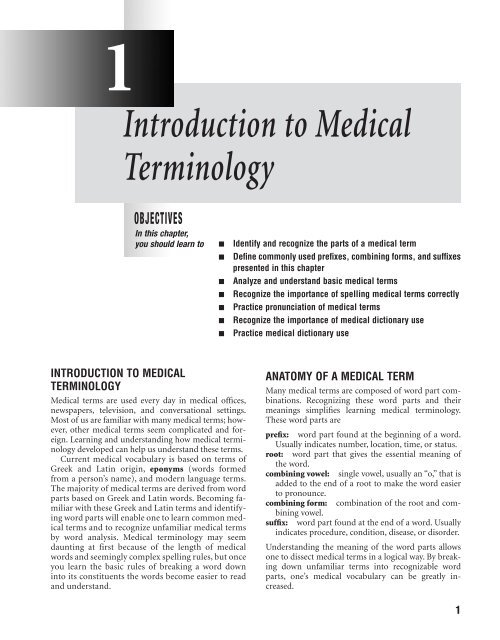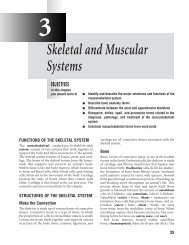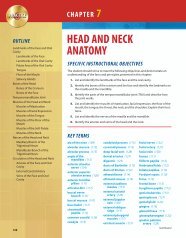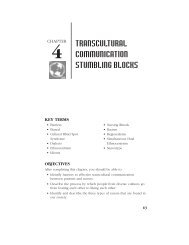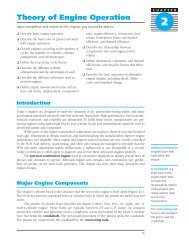Introduction to Medical Terminology - Delmar Learning - OPG Tools
Introduction to Medical Terminology - Delmar Learning - OPG Tools
Introduction to Medical Terminology - Delmar Learning - OPG Tools
Create successful ePaper yourself
Turn your PDF publications into a flip-book with our unique Google optimized e-Paper software.
1<br />
<strong>Introduction</strong> <strong>to</strong> <strong>Medical</strong><br />
<strong>Terminology</strong><br />
OBJECTIVES<br />
In this chapter,<br />
you should learn <strong>to</strong><br />
INTRODUCTION TO MEDICAL<br />
TERMINOLOGY<br />
<strong>Medical</strong> terms are used every day in medical offices,<br />
newspapers, television, and conversational settings.<br />
Most of us are familiar with many medical terms; however,<br />
other medical terms seem complicated and foreign.<br />
<strong>Learning</strong> and understanding how medical terminology<br />
developed can help us understand these terms.<br />
Current medical vocabulary is based on terms of<br />
Greek and Latin origin, eponyms (words formed<br />
from a person’s name), and modern language terms.<br />
The majority of medical terms are derived from word<br />
parts based on Greek and Latin words. Becoming familiar<br />
with these Greek and Latin terms and identifying<br />
word parts will enable one <strong>to</strong> learn common medical<br />
terms and <strong>to</strong> recognize unfamiliar medical terms<br />
by word analysis. <strong>Medical</strong> terminology may seem<br />
daunting at first because of the length of medical<br />
words and seemingly complex spelling rules, but once<br />
you learn the basic rules of breaking a word down<br />
in<strong>to</strong> its constituents the words become easier <strong>to</strong> read<br />
and understand.<br />
Identify and recognize the parts of a medical term<br />
Define commonly used prefixes, combining forms, and suffixes<br />
presented in this chapter<br />
Analyze and understand basic medical terms<br />
Recognize the importance of spelling medical terms correctly<br />
Practice pronunciation of medical terms<br />
Recognize the importance of medical dictionary use<br />
Practice medical dictionary use<br />
ANATOMY OF A MEDICAL TERM<br />
Many medical terms are composed of word part combinations.<br />
Recognizing these word parts and their<br />
meanings simplifies learning medical terminology.<br />
These word parts are<br />
prefix: word part found at the beginning of a word.<br />
Usually indicates number, location, time, or status.<br />
root: word part that gives the essential meaning of<br />
the word.<br />
combining vowel: single vowel, usually an “o,” that is<br />
added <strong>to</strong> the end of a root <strong>to</strong> make the word easier<br />
<strong>to</strong> pronounce.<br />
combining form: combination of the root and combining<br />
vowel.<br />
suffix: word part found at the end of a word. Usually<br />
indicates procedure, condition, disease, or disorder.<br />
Understanding the meaning of the word parts allows<br />
one <strong>to</strong> dissect medical terms in a logical way. By breaking<br />
down unfamiliar terms in<strong>to</strong> recognizable word<br />
parts, one’s medical vocabulary can be greatly increased.<br />
1
2 Chapter 1<br />
TABLE 1–1<br />
Contrasting Prefixes<br />
Without a prefix the root traumatic means pertaining <strong>to</strong><br />
injury.<br />
Without a prefix the root uria means urination.<br />
ab- (ahb) means away from.<br />
abduction means <strong>to</strong> take away from midline.<br />
Without a prefix the root emetic means pertaining <strong>to</strong><br />
vomiting.<br />
dys- (dihs) means difficult, painful, or bad.<br />
dysphagia means difficulty eating or swallowing.<br />
endo- (ehn-dō) means within or inside.<br />
endocrine means <strong>to</strong> secrete internally.<br />
endo- means within or inside.<br />
endoparasite is an organism that lives within the body of<br />
the host.<br />
hyper- (hī-pər) means elevated or more than normal.<br />
hyperglycemia means elevated amounts of blood<br />
glucose.<br />
inter- (ihn-tər) means between.<br />
intercostal means between the ribs.<br />
poly- (pohl-ē) means many.<br />
polyuria means elevated amount or frequency of<br />
urination.<br />
pre- (prē) means before.<br />
preanesthetic means pertaining <strong>to</strong> before anesthesia.<br />
sub- (suhb) means below, under, or less.<br />
sublingual means under the <strong>to</strong>ngue.<br />
Prefixes<br />
Prefixes are added <strong>to</strong> the beginning of a word or root <strong>to</strong><br />
modify its meaning. For example, the term operative<br />
can be modified using various prefixes.<br />
The prefix pre- means before. Preoperative means<br />
before or preceding an operation.<br />
The prefix peri- (pehr-e) means around. Perioperative<br />
means pertaining <strong>to</strong> the period around an operation or<br />
the period before, during, and after an operation.<br />
The prefix post- means after. Pos<strong>to</strong>perative means<br />
after an operation.<br />
Many prefixes have another prefix whose meaning is<br />
opposite of its own. Initially, when learning prefixes it<br />
is helpful <strong>to</strong> learn them in these pairs or in similar<br />
groups (Table 1–1 and Figure 1–1).<br />
Combining Vowels<br />
A combining vowel sometimes is used <strong>to</strong> make the<br />
medical term easier <strong>to</strong> pronounce. The combining<br />
vowel is used when the suffix begins with a consonant,<br />
a- (ah or ā) means without or no.<br />
atraumatic means without injury.<br />
an- (ahn) means without or no.<br />
anuria means absence of urine.<br />
ad- (ahd) means <strong>to</strong>ward.<br />
adduction means move <strong>to</strong>ward the midline.<br />
anti- (ahn-tī or ahn-tih) means against.<br />
antiemetics work against or prevent vomiting.<br />
eu- (yoo) means good, easy, or normal.<br />
euthyroid means having a normally functioning thyroid<br />
gland.<br />
ex- (ehcks) or exo- (ehcks-ō) means without, out of,<br />
outside, or away from.<br />
exocrine means <strong>to</strong> secrete externally (via a duct).<br />
ec<strong>to</strong>- (ehck-tō) means outside.<br />
ec<strong>to</strong>parasite is an organism that lives on the outer surface<br />
of the host.<br />
hypo- (hī-pō) means depressed or less than normal.<br />
hypoglycemia means depressed amounts of blood<br />
glucose.<br />
intra- (ihn-trah) means within.<br />
intramuscular means within the muscle.<br />
oligo- (ohl-ih-gō) means scant or little.<br />
oliguria means depressed amount or frequency of<br />
urination.<br />
post- (pōst) means after.<br />
postanesthetic means pertaining <strong>to</strong> after anesthesia.<br />
super- (soo-pər) and supra- (soo-prah) mean above,<br />
beyond, or excessive.<br />
supernumerary means more than the regular number.<br />
suprascapular means above the shoulder blade.<br />
Ultra, super, supra<br />
hyper Epi<br />
Per<br />
Inter Intra Extra<br />
Trans<br />
Infra Sub, hypo<br />
FIGURE 1–1 Directional prefixes<br />
Meta<br />
as in the suffix -scope. An arthroscope is an instrument<br />
<strong>to</strong> visually examine the joint. Because the suffix<br />
-scope begins with a consonant, the combining vowel<br />
“o” is used. “O” is the most commonly used combining<br />
vowel; however, “i” and “e” may be used as well. A<br />
combining vowel is not used when the suffix begins<br />
with a vowel, as in the suffix -itis. Gastritis is inflammation<br />
of the s<strong>to</strong>mach. Because the suffix -itis begins<br />
with a vowel, the combining vowel “o” is not used. A
TABLE 1-2<br />
Directional Prefixes and Their Meanings<br />
Prefix Pronunciation Definition<br />
epi (eh-pē) upper<br />
extra (ehcks-trah) outside<br />
hyper (hi-pər) above, increased, or more<br />
than normal<br />
hypo (hī-pō) below, under, or decreased<br />
infra (ihn-frah) below or beneath<br />
inter (ihn-tər) between<br />
intra (ihn-trah) within<br />
meta (meht-ah) beyond<br />
per (pər) throughout<br />
sub (suhb) below, under, or decreased<br />
super (soo-pər) above, increased, or more<br />
than normal<br />
supra (soo-prah) above, increased, or more<br />
than normal<br />
trans (trahnz) across<br />
ultra (uhl-trah) above, increased, or more<br />
than normal<br />
combining vowel is always used when two or more<br />
root words are joined. For example, when gastr/o<br />
(s<strong>to</strong>mach) is joined with enter/o (small intestine) the<br />
combining vowel is used with gastr/o, as in the term<br />
gastroenteritis. A combining vowel is not used between<br />
a prefix and the root word.<br />
Combining Forms<br />
A word root plus a vowel is the combining form.<br />
Combining forms usually describe a part of the body.<br />
New words are created when combining forms are<br />
added <strong>to</strong> prefixes, other combining forms, and suffixes.<br />
For example, the term panleukopenia is composed of<br />
the word parts<br />
pan- (pahn), a prefix meaning all<br />
leuk/o (loo-kō), a combining form meaning white<br />
-penia (pē-nē-ah), a suffix meaning deficiency or<br />
reduction in number<br />
Panleukopenia is a deficiency of all types of white<br />
blood cells.<br />
Suffixes<br />
Suffixes are attached <strong>to</strong> the end of a word part <strong>to</strong> modify<br />
its meaning. For example, the combining form<br />
gastr/o means s<strong>to</strong>mach and can be modified using various<br />
suffixes.<br />
The suffix -<strong>to</strong>my means cutting in<strong>to</strong> or incision.<br />
Gastro<strong>to</strong>my is incision in<strong>to</strong> the s<strong>to</strong>mach.<br />
The suffix -s<strong>to</strong>my means a surgically created opening.<br />
Gastros<strong>to</strong>my is a surgically created opening between<br />
the s<strong>to</strong>mach and the body surface.<br />
The suffix -ec<strong>to</strong>my means surgical removal or excision.<br />
Gastrec<strong>to</strong>my is surgical removal of the s<strong>to</strong>mach.<br />
Many suffixes can be grouped <strong>to</strong>gether by meaning or<br />
by the category they modify. Initially, when learning<br />
suffixes it is easiest if the learner groups them by meaning<br />
or category.<br />
“PERTAINING TO” SUFFIXES<br />
-ac (ahck), as in cardiac (pertaining <strong>to</strong> the heart)<br />
-al (ahl), as in renal (pertaining <strong>to</strong> the kidney)<br />
-an (ahn), as in ovarian (pertaining <strong>to</strong> the ovary)<br />
-ar (ahr), as in lumbar (pertaining <strong>to</strong> the loin)<br />
-ary (ahr-ē), as in alimentary (pertaining <strong>to</strong> the gastrointestinal<br />
tract)<br />
-eal (ē-ahl), as in laryngeal (pertaining <strong>to</strong> the larynx)<br />
-ic (ihck), as in enteric (pertaining <strong>to</strong> the intestines)<br />
-ine (ihn), as in uterine (pertaining <strong>to</strong> the uterus)<br />
-ous (uhs), as in cutaneous (pertaining <strong>to</strong> the skin)<br />
-tic (tihck), as in nephrotic (pertaining <strong>to</strong> the kidneys)<br />
SURGICAL SUFFIXES<br />
-ec<strong>to</strong>my (ehck-tō-mē) surgical removal, as in<br />
mastec<strong>to</strong>my, surgical removal of the breast or mammary<br />
glands<br />
-pexy (pehck-sē) suture <strong>to</strong> stabilize, as in<br />
gastropexy, surgically stabilizing the s<strong>to</strong>mach <strong>to</strong> the<br />
abdominal wall<br />
-plasty (plahs-tē) surgical repair, as in rhinoplasty,<br />
surgical repair of the nose<br />
-s<strong>to</strong>my (stō-mē) surgically created opening, as in<br />
colos<strong>to</strong>my, a surgically created opening between the<br />
colon and body surface<br />
-<strong>to</strong>my (tō-mē) cutting in<strong>to</strong>, as in laparo<strong>to</strong>my, an<br />
incision in<strong>to</strong> the abdomen<br />
PROCEDURAL SUFFIXES<br />
<strong>Introduction</strong> <strong>to</strong> <strong>Medical</strong> <strong>Terminology</strong> 3<br />
-centesis (sehn-tē-sihs) surgical puncture <strong>to</strong> remove<br />
fluid or gas (either for diagnosis or <strong>to</strong> remove<br />
excess fluid or gas), as in cys<strong>to</strong>centesis, a surgical<br />
puncture of the urinary bladder with a needle <strong>to</strong> remove<br />
fluid (urine)<br />
-gram (grahm) record of, as in electrocardiogram,<br />
the electrocardiographic hard copy<br />
record<br />
-graph (grahf) instrument that records (or used<br />
as record), as in electrocardiograph, the machine<br />
that records the electrical activity of the heart<br />
-graphy (grahf-ē) procedure that records, as in<br />
electrocardiography, the procedure used <strong>to</strong> record<br />
the electrical activity of the heart<br />
-lysis (lī-sihs) separation or breakdown, as in
4 Chapter 1<br />
urinalysis, separation of the urine in<strong>to</strong> its constituents<br />
-scope (skōp) instrument <strong>to</strong> visually examine, as<br />
in endoscope, an instrument used <strong>to</strong> visually examine<br />
inside the body<br />
-scopy (skōp-ē) procedure <strong>to</strong> visually examine, as<br />
in endoscopy, the procedure of visually examining<br />
inside the body<br />
-therapy (thehr-ah-pē) treatment, as in chemotherapy,<br />
treatment with chemical substances or<br />
drugs<br />
DOUBLE “R” SUFFIXES<br />
-rrhagia or -rrhage (rā-jē-ah or rihdj) bursting<br />
forth, as in hemorrhage, bursting forth of blood<br />
from the vessels<br />
-rrhaphy (rahf-ē) <strong>to</strong> suture, as in enterorrhaphy,<br />
suturing of the intestines<br />
-rrhea (rē-ah) flow, discharge, as in diarrhea,<br />
complete discharge of the bowels<br />
-rrhexis (rehck-sihs) rupture, as in myorrhexis,<br />
rupture of the muscle<br />
What is the difference between human and<br />
veterinary medical terminology?<br />
Most times, the medical terms used in human medical<br />
settings are identical <strong>to</strong> the ones used in veterinary medical settings.<br />
The greater number of species in veterinary medicine and<br />
the addition of terms used in animal production greatly expand the<br />
vocabulary of veterinary professionals. Species-specific ana<strong>to</strong>mical<br />
differences also influence the terms used in a specific area. Do<br />
you know where the calf muscle is located on a person? Where is<br />
the calf muscle in a calf?<br />
CONDITIONAL SUFFIXES<br />
-algia and -dynia (ahl-jē-ah or dihn-ē-ah) pain,<br />
as in arthralgia and arthrodynia, or joint pain<br />
-itis (ī-tihs) inflammation, as in hepatitis, inflammation<br />
of the liver<br />
-malacia (mah-lā-shē-ah) abnormal softening, as<br />
in osteomalacia, abnormal softening of bone<br />
-megaly (mehg-ah-lē) enlargement, as in cardiomegaly,<br />
enlargement of the heart<br />
-osis (ō-sihs) abnormal condition, as in cardiosis,<br />
an abnormal condition of the heart<br />
-pathy (pahth-ē) disease, as in enteropathy, disease<br />
of the intestines<br />
-sclerosis (skleh-rō-sihs) abnormal hardening, as in<br />
arteriosclerosis, abnormal hardening of the arteries<br />
-um (uhm) structure, as in pericardium, the<br />
structure surrounding the heart<br />
Noun<br />
cyanosis<br />
anemia<br />
mucus<br />
ilium<br />
condyle<br />
carpus<br />
Suffix<br />
-osis<br />
-emia<br />
-us<br />
-um<br />
-e<br />
-us<br />
Adjective<br />
cyanotic<br />
anemic<br />
mucous<br />
iliac<br />
condylar<br />
carpal<br />
Suffix<br />
-tic<br />
Suffixes may change the part of speech of a word.<br />
Different suffixes may change the word from a noun<br />
(naming people, places, or things) <strong>to</strong> an adjective<br />
(descrip<strong>to</strong>r) (Figure 1-2). Examples of this include<br />
cyanosis is a noun meaning condition of blue discoloration,<br />
whereas cyanotic is an adjective<br />
meaning pertaining <strong>to</strong> blue discoloration<br />
anemia is a noun meaning a blood condition of deficient<br />
red blood cells or hemoglobin, whereas<br />
anemic is an adjective meaning pertaining <strong>to</strong> a<br />
blood condition of deficient red blood cells or hemoglobin<br />
mucus is a noun meaning a slime-like substance that is<br />
composed of glandular secretion, salts, cells, and<br />
leukocytes, whereas mucous is an adjective meaning<br />
pertaining <strong>to</strong> mucus<br />
ilium is a noun meaning a part of the hip, whereas iliac<br />
is an adjective pertaining <strong>to</strong> the hip<br />
condyle is a noun meaning a rounded projection on a<br />
bone, whereas condylar is an adjective meaning pertaining<br />
<strong>to</strong> a rounded projection on a bone<br />
carpus is a noun meaning the joint between the radius<br />
and ulna and metacarpal bones, whereas carpal is an<br />
adjective meaning pertaining <strong>to</strong> the joint between<br />
the radius and ulna and metacarpal bones<br />
ANALYZING MEDICAL TERMS<br />
<strong>Medical</strong> terminology can be more easily unders<strong>to</strong>od if<br />
the following objectives are adhered <strong>to</strong>:<br />
Dissect: First analyze the word structurally by dividing<br />
it in<strong>to</strong> its basic components.<br />
Begin at the end: After dividing the word in<strong>to</strong> its<br />
basic parts, define the suffix first, the prefix second,<br />
and then the roots. If there are two roots, divide each<br />
and read them from left <strong>to</strong> right.<br />
Ana<strong>to</strong>mical order: Where body systems are involved,<br />
the words usually are built in the order in<br />
-ic<br />
-ous<br />
-ac<br />
-ar<br />
-al<br />
FIGURE 1–2 Suffix variation depending on usage
which the organs occur in the body. For example,<br />
gastroenteritis is the proper term for inflammation<br />
of the s<strong>to</strong>mach and small intestine. Because food<br />
passes from the s<strong>to</strong>mach in<strong>to</strong> the small intestine, the<br />
medical term for s<strong>to</strong>mach appears before the medical<br />
term for small intestine. The order of word parts<br />
in a medical term may also represent the order of<br />
blood flow through organs. The exception <strong>to</strong> this involves<br />
some diagnostic procedures in which <strong>to</strong>ols or<br />
substances are passed retrograde or in the opposite<br />
direction of ana<strong>to</strong>mic order. In these cases the words<br />
are built in the order in which the equipment passes<br />
the body part.<br />
Using these guidelines, analyze the term ovariohysterec<strong>to</strong>my.<br />
First divide the term in<strong>to</strong> its basic components:<br />
ovari/o/hyster/ec<strong>to</strong>my. Defining from back <strong>to</strong> front, the<br />
suffix -ec<strong>to</strong>my is surgical removal, one combining form<br />
ovari/o means ovary,and the other combining form hysteri/o<br />
means uterus. Together the term ovariohysterec<strong>to</strong>my<br />
means surgical removal of the ovaries and uterus.<br />
This term is based on the order in which the ovaries and<br />
uterus are found in the body.<br />
WHAT DID YOU SAY?<br />
Proper pronunciation of medical terms takes time and<br />
practice. Listening <strong>to</strong> how words are pronounced by<br />
medical professionals and using medical dictionaries<br />
and textbooks are the best ways <strong>to</strong> learn pronunciation.<br />
There will be individual variations in geographic location<br />
or personal preference. <strong>Medical</strong> dictionaries also<br />
vary in how they present pronunciation of medical<br />
terms. Some sources mark the syllable receiving the<br />
greatest emphasis with a primary accent () and the<br />
syllable receiving the second most emphasis with a secondary<br />
accent (). Other sources boldface and capitalize<br />
the syllable receiving the most emphasis, and other<br />
sources do not emphasize syllables. Consult with your<br />
reference before pronouncing the word.<br />
General Pronunciation Guidelines<br />
Vowels can either be short or long (Table 1–3).<br />
Consonants are generally pronounced as in other<br />
English words.<br />
DOES SPELLING COUNT?<br />
Be aware of spelling when using medical terminology.<br />
Changing one or two letters can change the meaning of<br />
a word. Hepa<strong>to</strong>ma is a liver mass, whereas hema<strong>to</strong>ma<br />
is a mass or collection of blood. The urethra takes<br />
urine from the urinary bladder <strong>to</strong> the outside of the<br />
body, whereas ureters collect urine from the kidney<br />
<strong>Introduction</strong> <strong>to</strong> <strong>Medical</strong> <strong>Terminology</strong> 5<br />
and transport it <strong>to</strong> the urinary bladder. <strong>Medical</strong> terms<br />
may be pronounced the same but have different meanings,<br />
so spelling is important. For example, ileum and<br />
ilium are pronounced the same. However, ileum is the<br />
distal part of the small intestine (e enter/o or<br />
e eating), whereas ilium is part of the pelvic bone<br />
(pelvic has i in it). Some medical terms actually have<br />
the same spelling as terms used for other body parts.<br />
For example, the combining form myel/o represents<br />
the spinal cord and bone marrow (it originates from<br />
the term meaning white substance). Other terms have<br />
different spellings depending on how the term is used<br />
grammatically. For example, when used as a noun<br />
mucus (the slimy stuff secreted from mucous membranes)<br />
is spelled differently than when it is used as an<br />
adjective (as in mucous membrane).<br />
When you are looking a medical term up in the<br />
dictionary, spelling plays an important role.<br />
TABLE 1–3<br />
Pronunciation of Guide<br />
Vowel Sound Example<br />
“a” at the end of a word ah idea<br />
“ae” followed by r or s ah aerobic<br />
“i” at the end of a word ī bronchi<br />
“oe” eh oestrogen (old<br />
English form)<br />
“oi” oy sarcoid<br />
“eu” ū euthanasia<br />
“ei” ī Einstein<br />
“ai” ay air<br />
“au” aw audi<strong>to</strong>ry<br />
Exceptions <strong>to</strong> Consonant Pronunciations<br />
Consonant Sound Example<br />
“c” before e, i, and y s cecum<br />
“c” before a, o, and u k cancer<br />
“g” before e, i, and y j genetic<br />
“g” before a, o, and u g gall<br />
“ps” at beginning of word s psychology<br />
“pn” at beginning of word n pneumonia<br />
“c” at end of word k anemic<br />
“cc” followed by i or y first c k, accident<br />
second<br />
c s<br />
“ch” at beginning of word k chemistry<br />
“cn” in middle of word both c (pro- gastrocnemius<br />
nounce k)<br />
and n (pro-<br />
nounce ehn)<br />
“mn” in middle of word both amnesia<br />
m and n<br />
“pt” at beginning of word t pterodactyl<br />
“pt” in middle of word both p and t optical<br />
“rh” r rhinoceros<br />
“x” at beginning of word z xylophone
6 Chapter 1<br />
However, the term may not be spelled the way it<br />
sounds. The following guidelines can be used <strong>to</strong> find<br />
a word in the dictionary:<br />
If it sounds like f, it may begin with f or ph.<br />
If it sounds like j, it may begin with g or j.<br />
REVIEW EXERCISES<br />
Matching: Match the word parts in Column I with the definition in Column II.<br />
Column I Column II<br />
1. -itis a. incision or cutting in<strong>to</strong><br />
2. -gram b. before<br />
3. post- c. surgical puncture <strong>to</strong> remove fluid<br />
4. -<strong>to</strong>my d. difficult, painful, or bad<br />
5. pre- e. enlargement<br />
6. -centesis f. excision or surgical removal<br />
7. -therapy g. liver<br />
8. dys- h. kidney<br />
9. peri- i. inflammation<br />
10. ren/o j. record<br />
11. hepat/o k. after<br />
12. -megaly l. treatment<br />
13. -ec<strong>to</strong>my m. around<br />
Write the medical term that represents the following definitions.<br />
1. Pertaining <strong>to</strong> the s<strong>to</strong>mach<br />
2. Inflammation of the liver<br />
3. Abnormal softening of bone<br />
4. Joint pain<br />
5. Procedure <strong>to</strong> visually examine inside the body<br />
6. Heart enlargement<br />
7. Pertaining <strong>to</strong> the kidney<br />
8. Bursting forth of blood from vessels<br />
9. Suturing of s<strong>to</strong>mach <strong>to</strong> body wall<br />
10. Treatment with chemicals or drugs<br />
Multiple Choice: Choose the correct answer.<br />
1. The prefix means away from midline.<br />
a. adb.abc.exd.<br />
endo-<br />
2. The suffix means instrument <strong>to</strong> visually<br />
examine.<br />
a. -ec<strong>to</strong>my<br />
b. -scope<br />
c. -scopy<br />
d. -graphy<br />
If it sounds like k, it may begin with c, ch, k, or qu.<br />
If it sounds like s, it may begin with c, ps, or s.<br />
If it sounds like z, it may begin with x or z.<br />
3. The prefix means elevated, while the prefix<br />
means depressed.<br />
a. pre-, postb.<br />
endo-, exoc.<br />
hyper-, hypod.<br />
inter-, intra-<br />
4. The suffix means pertaining <strong>to</strong>.<br />
a. -al<br />
b. -ary or -ar<br />
c. -ic<br />
d. all of the above
5. The suffix means incision.<br />
a. -ex<br />
b. -<strong>to</strong>my<br />
c. -ec<strong>to</strong>my<br />
d. -graphy<br />
6. The suffix means abnormal condition.<br />
a. -osis<br />
b. -rrhea<br />
c. -rrhagia<br />
d. -uria<br />
7. The suffix means separation or breaking<br />
in<strong>to</strong> parts.<br />
a. -gram<br />
b. -pexy<br />
c. -um<br />
d. -lysis<br />
8. The prefix means below.<br />
a. suprab.superc.interd.<br />
sub-<br />
9. The prefix(es) means many.<br />
a. oligb.<br />
a-, anc.polyd.<br />
eu-<br />
10. The prefix(es) means without or no.<br />
a. a-, anb.oligc.dysd.<br />
hyper-<br />
11. The suffix -algia means<br />
a. pain<br />
b. excessive<br />
c. liver<br />
d. abnormal condition<br />
12. The prefix pre- means<br />
a. after<br />
b. around<br />
c. before<br />
d. during<br />
Word Part Identification: Underline the word root(s) in the following terms.<br />
1. hepat/itis<br />
2. gastr/o/intestin/al<br />
3. cardi/o/logy<br />
<strong>Introduction</strong> <strong>to</strong> <strong>Medical</strong> <strong>Terminology</strong> 7<br />
13. An instrument <strong>to</strong> visually examine may have which<br />
suffix in its term?<br />
a. –lysis<br />
b. –scope<br />
c. –rrhexis<br />
d. –scopy<br />
14. Which type of word part is always placed at the end of<br />
a term?<br />
a. combining form<br />
b. prefix<br />
c. suffix<br />
d. root<br />
15. Which type of word part is always placed at the beginning<br />
of a term?<br />
a. combining form<br />
b. prefix<br />
c. suffix<br />
d. root<br />
16. Which word part gives the essential meaning of a term?<br />
a. combining form<br />
b. prefix<br />
c. suffix<br />
d. root<br />
17. Which word association is incorrect?<br />
a. inter- means between<br />
b. sub- means below, under, or less<br />
c. an- means without or no<br />
d. ad- means away from<br />
18. Which suffix means <strong>to</strong> rupture?<br />
a. -rrhage<br />
b. -rrhaphy<br />
c. -rrhea<br />
d. -rrhexis<br />
19. Which prefix means around?<br />
a. hyperb.hypoc.perid.<br />
supra-<br />
20. In the term panleukopenia, the “o” between the “leuk”<br />
and “penia” is called<br />
a. a combining form<br />
b. a suffix<br />
c. a combining vowel<br />
d. a root<br />
4. intra/ven/ous<br />
5. nephr/osis
8 Chapter 1<br />
Underline the suffix in the following terms.<br />
6. hepat/itis<br />
7. gastr/o/intestin/al<br />
8. cardi/o/logy<br />
9. intra/ven/ous<br />
10. nephr/osis<br />
Underline the prefix in the following terms.<br />
11. hyper/secretion<br />
12. peri/card/itis<br />
13. endo/cardi/um<br />
14. poly/uria<br />
15. ur/o/lith<br />
Case Study: Fill in the blanks <strong>to</strong> complete the case his<strong>to</strong>ry.<br />
A 5-yr-old M, neutered cat is presented <strong>to</strong> a veterinary clinic<br />
with (painful urination) and<br />
(scant urine production). Upon examination the abdomen<br />
is palpated and (an enlarged urinary bladder)<br />
is noted. After completing the examination, the veterinarian<br />
suspects an obstruction of the (the tube<br />
that carries urine from the urinary bladder <strong>to</strong> outside the<br />
body). Blood is taken for analysis, and the cat is admitted<br />
<strong>to</strong> the clinic. The cat is anesthetized, and a urinary catheter<br />
is passed. Urine is collected for (breakdown of<br />
urine in<strong>to</strong> its components). In addition <strong>to</strong> the obstruction,<br />
the cat is treated for (inflammation of the<br />
urinary bladder).<br />
In this case study, the meanings of some unfamiliar<br />
medical terms (underlined) cannot be unders<strong>to</strong>od by<br />
breaking up the term in<strong>to</strong> its basic components. Using<br />
a dictionary or dictionary Web site, define the following<br />
medical terms<br />
1. palpated<br />
2. obstruction<br />
3. catheter


